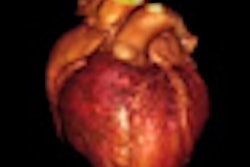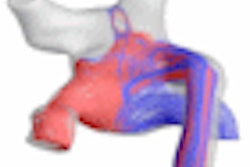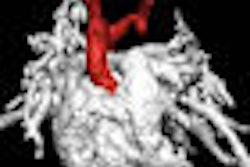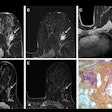Cardiac MRI can predict the likely tumor type in a majority of children with a cardiac mass, but cannot always conclusively determine if the tumor is malignant, according to a study in the August 30 issue of the Journal of the American College of Cardiology.
The international study from 15 pediatric cardiac imaging centers in the U.S. and Europe also concluded that a "comprehensive imaging protocol is essential for accurate diagnosis," and that histologic diagnosis remains "the gold standard" in this clinical application (JACC, Vol. 58:10, pp. 1044-1054).
Lead study author is Dr. Rebecca Beroukhim from the department of cardiology at Children's Hospital Boston and Harvard Medical School in Boston.
Cardiac ailments
The researchers retrospectively reviewed cases of 78 children age 18 years or younger who had received an MRI scan for a cardiac tumor. The children had also received a histologic diagnosis of a tumor or a diagnosis of tuberous sclerosis. Tuberous sclerosis is a genetic disease that causes nonmalignant tumors to grow on organs, such as the heart, kidneys, eyes, lungs, and skin, as well as in the brain.
The children presented with various cardiac afflictions, which included 29 cases of arrhythmia, 12 children with a heart murmur, and 15 patients with clinical symptoms, such as respiratory distress. There also were six cases of chest pain, four patients with fatigue, and two children with dizziness.
Among the patients with benign tumors, 66 children (87%) underwent partial or complete tumor resection, while the remaining patients received a biopsy only.
Most patients with benign tumors were asymptomatic at last follow-up. However, there were three deaths among patients with benign tumors: one fibroma (perioperative death), one hemangioma (perioperative death), and one rhabdomyoma (died awaiting heart transplantation).
Three readers who were blinded to the histologic diagnoses evaluated the cardiac MR images for tumor type and compared their diagnoses with the histologic results.
Diagnostic accuracy
Compared with the histologic diagnoses, the three readers correctly diagnosed 76 (97%) of the 78 cases, but included a differential diagnosis in 42%. Better image quality grade and more complete examination were associated with higher diagnostic accuracy.
Of the 78 cases, 43 children (55%) were given a single correct diagnosis, and 33 patients (42%) received the correct diagnosis as part of a differential diagnosis. Among the cases with a differential diagnosis, 16 children had two possible diagnoses, while 18 patients had three possible diagnoses.
The diagnoses included 30 children with fibromas, 14 patients with rhabdomyomas, 12 children malignant tumors, nine cases of hemangioma, and four children with a thrombus. There were also three cases of myxoma, two children with teratomas, and one case each of paraganglioma, pericardial cyst, Purkinje cell tumor, and papillary fibroelastoma.
There were only two cases with an incorrect diagnosis, with both children having an atypical appearance on their cardiac MR images.
MR image quality
MR image quality was good or very good in 81% of cases, and tumors were discovered in all cardiac chambers and extracardiac locations, with the most common sites in the right or left ventricular wall or ventricular septum.
As one might expect, Beroukhim and colleagues found that a single accurate diagnosis was primarily the result of a more complete examination and better image quality. The majority of cases with a complete examination (40 of 47 cases, or 85%) had a single correct diagnosis as compared with only three of 31 cases (10%) with an incomplete study.
Very good image quality resulted in a single correct diagnosis in 19 (76%) of 25 cases, compared with 17 (45%) of 38 studies with good image quality, and seven (47%) of 15 cases where image quality was rated as fair.
Tumor malignancy
"However, a higher image quality grade was not associated with better diagnostic accuracy when controlling for completeness of examination," the authors also wrote. "Of the 47 complete studies, 34 of 41 (83%) with good image quality versus six of six (100%) studies with fair image quality had a single accurate diagnosis."
In addition, among 31 incomplete studies, two (9%) of 22 cases with good image quality had a single accurate diagnosis, compared with only one (11%) of nine studies with fair image quality.
All 12 malignant tumors identified in the study were diagnosed correctly as malignant or possibly malignant, with three of the dozen tumors classified as primary cardiac malignancies.
The authors noted that the retrospective approach may be one limitation of the research, because it precluded a uniform imaging protocol, which resulted in variable image quality and degrees of examination completion.



.fFmgij6Hin.png?auto=compress%2Cformat&fit=crop&h=100&q=70&w=100)




.fFmgij6Hin.png?auto=compress%2Cformat&fit=crop&h=167&q=70&w=250)











